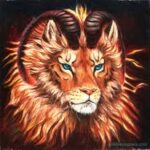Note: I wrote this report on my journey home from World Fantasy 2014, but I’m posting it from the comfort of my room, with a hot cup of tea in one hand, and the knowledge that I don’t have to fly anywhere until well into next year.
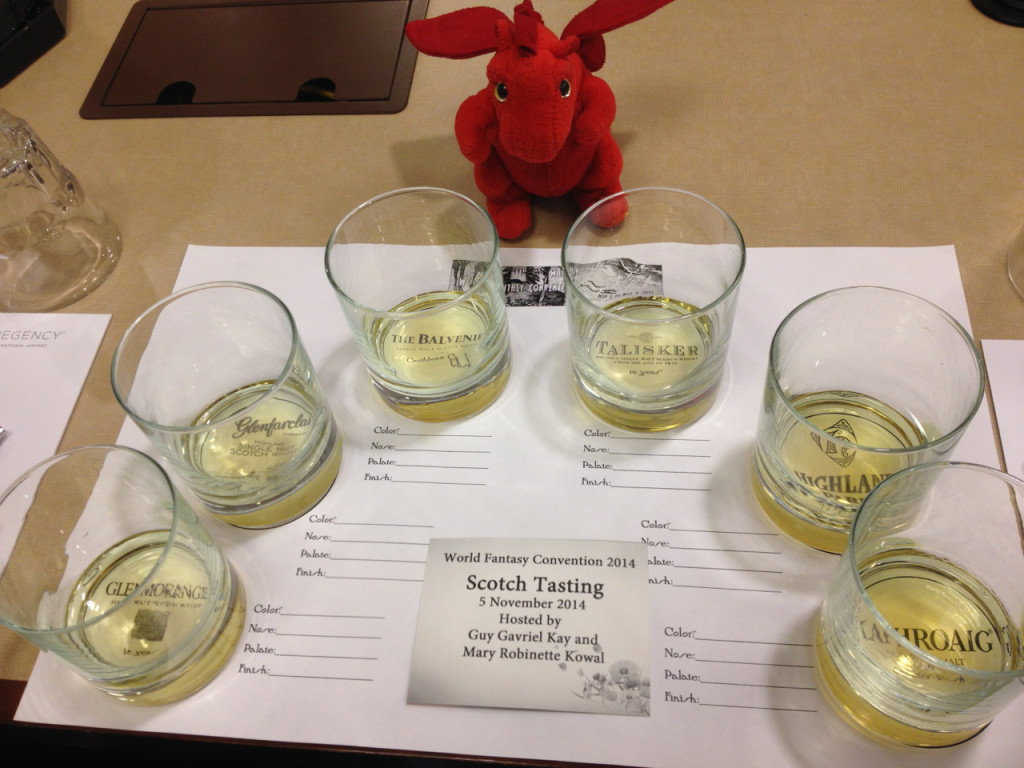
I am writing this in Reagan Airport, waiting for a plane to take me home from World Fantasy 2014. I grabbed some interesting-looking candy from the Hospitality Suite that I thought would be the hard, sugary kind one sucked on, but it turns out they are really fantastic chocolates. One has mocha and coffee bits, and the a Kahlúa-caramel center. I am eating them while drinking tea in a miraculously-free charging booth at Gate 16.
Which has more or less been the theme of this convention for me. Which is to say: it was very, very good.
In no particular order:
The location (The Hyatt Regency Crystal City) turned out to be much better than I expected. Next door to Reagan airport, it also had good access to streets filled with restaurants and the Mt Vernon pedestrian trail, which the Wonderful Mother and I made good use of in our morning runs. Except for Friday, when we took the Metro to the National Mall and ran around in it, but that’s another story.
Of the nearby eateries, my favorites were undoubtedly Enjera Ethiopian Restaurant and Bistro 7107—the latter being my first taste of Filipino (Philippine) cuisine, and I’m afraid they set the bar very, very high. Both are on S 23rd St between Eads and Fern and if you are ever in Crystal City I highly recommend them.
All this was a complete and delightful surprise, as I had feared that the Hyatt would be in the typical Freeway Wasteland that often surrounds airports. (There were a lot of big roads, to be fair, but it was more of a jungle than a desert.)
The hotel itself was lovely: spacious and airy with comfortable rooms and an extremely helpful concierge. Though one of the charms of World Fantasy is that it moves around, I find myself wishing that I could be coming back to this location next year.
This World Fantasy is my fourth, but it was a first in many regards. This was the first time I actually sat in the Mass Autographing session on Friday night, since this was also the first year in which I had actual books which I could actually sign. I had them (or rather, other people had them) because this was the first year some very kind sponsors donated several boxes full of Professor Odd singles to the World Fantasy book bag. The result was that this was the first year I had people running up to me all weekend, in varying levels of excitement, clutching various assortments of Professor Odd. We had donated several hundred of them, but as this included five different issues, there was something of a collection game going on, made more interesting because there were more 1s than 2s than 3s than 4s, and only twenty-five copies of 5. Happily, several people managed to collect the whole set, and I was able to give each one an extra prize on top of it. Mostly, I was just happy people seemed to like them so much.
An Aside: one of the highlights of the con was Brenda Cooper running up to me at the banquet to get her copies signed. I had only known Brenda as the author lucky enough to have John Picacio put a fantastic picture on the cover of her book, The Creative Fire. Which I had nearly bought before purely on account of that, but stopped myself since I really didn’t know anything about her writing or her style. After attending her reading on Friday afternoon, however, I decided I wanted to read more of her work, and the next day spent a good half hour in the Dealer’s Hall asking around for Creative Fire. I finally found a copy, and promptly got Brenda (who was fortuitously wandering into the Hall just as I was leaving with my prize) to sign the title page. Then I ran off and got John to sign the cover. I haven’t gotten past the first page (purely because of time restraints!) but I think Ruby and I are going to be great friends, and I’m looking forward to reading it very much.
My double-signed copy of Creative Fire is only my second-most treasured prize of this convention, however. That distinction must go to the first (US) edition of The Lives of Christopher Chant, signed by the late, great, Diana Wynne Jones herself.
I try to acquire a Jones hardback at each genre con I attend—since, though my Jones collection is more or less complete, many of them are paperbacks—but have usually failed on account of nobody ever having any. Of the handful of dealers I asked this year, one did not have any, several did, but had not brought any to sell at the con, and one had two.
No, actually they only had one (the other had sold at their last con).
The one they had was a signed, first edition hardback of The Lives of Christopher Chant. It was carefully wrapped in a plastic envelope, and for its price I could have filled another World Fantasy book bag.
I went away biting my nails.
I told myself the signature really didn’t matter. I already had Diana Wynne Jones’s autograph. Three times over, in fact, on the three letters she’d written me over the course of the 00’s. What I wanted was a nice, hardback edition that I didn’t yet have (which Christopher Chant was)—but preferably not for a triple-digit price.
The signature really didn’t matter.
It didn’t.
I told all this to my Wonderful Mother, who listened patiently, then walked me back into the Dealer’s Hall and bought the book for me.
Later, when I was packing up my book haul, I took Chant out of its envelope to for a group photo. In the process of doing so I flipped it open, in the way one does with newly acquired books, and happened across the title page.
And would you believe, despite the stickers I had just peeled off the jacket protector proclaiming that it was so, I had forgotten it was an autographed copy? Perhaps the signature really hadn’t been important—until I actually saw it.
You hear about people’s distinctive handwriting in stories all the time. But never before had I been struck by just how much of a person is left behind in their writing.
Diana Wynne Jones passed away in the spring of 2011. The only connection we have to her now is things she left behind. But for me, who never got to meet her in person, the only connection I ever had with her was through her writing—both her books and her handwritten letters—so seeing a piece of that writing that I had never seen before was like seeing a loved one come back from the dead; this person who I thought I would never see again was suddenly there before me, whole and alive and full of energy, in a squiggly line of blue ballpoint.
At which time I’m afraid I melted down into tears and had to spent the next ten minutes sobbing uncontrollably. I’m crying now, writing this. I’m on a plane to Chicago (yes, we’ve moved along since I began this account) and I’m not even ashamed. If I learned anything from Diana Wynne Jones it’s that it doesn’t do to keep your emotions bottled up inside.
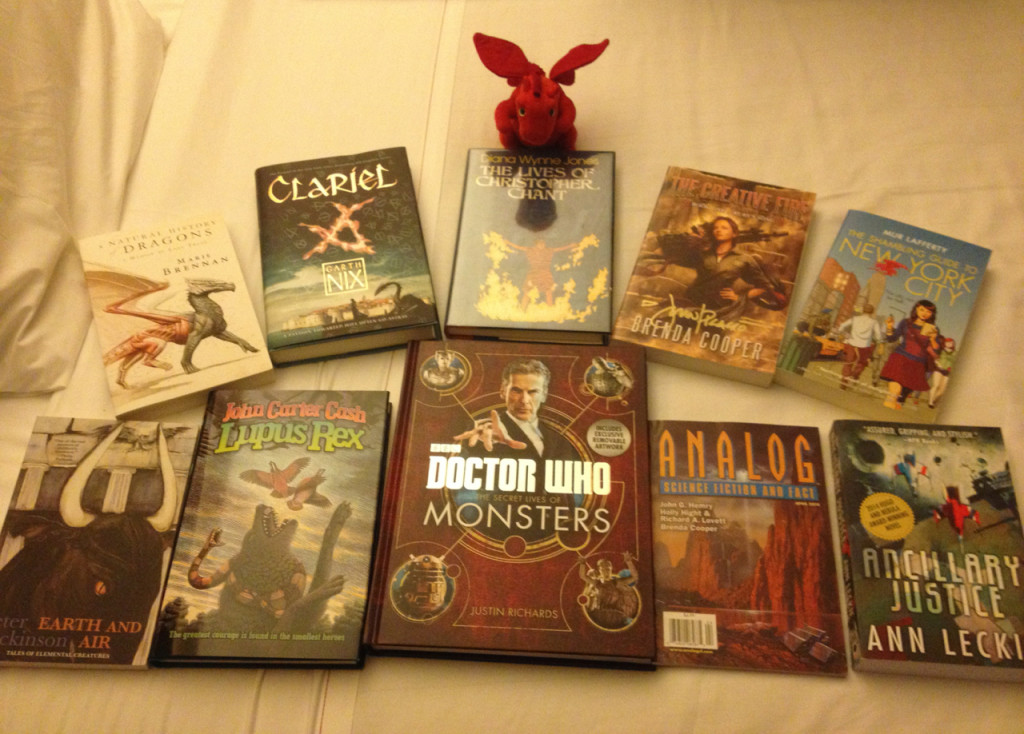
This weekend was also my first time moderating a panel. It happened by accident, really: I pointed out to Colleen Cahill that I might be a good person to have on the Animals in Fantasy discussion, and after having been placed on that panel I was then asked to moderate it. I said I would, if no one else wanted the job. Turned out no one did.
I have been on panels before, and I have also run panels insomuch as they were solo shows, but never before did I have the job of actually moderating conversation between a bunch of other people whom I barely knew. So I did what I always do when faced with a new discipline: I copied people who were extremely good at it (like Peter Sagal); I did the things I’d seen other people do which I liked (like communicate with the panelists beforehand, made sure the panel started and finished on time, and repeated questions from the audience into the microphone); and I tried not to do what I’d seen other people do which annoyed me (like obviously have no idea who their panelists were and talk more than the rest put together). And while it was certainly a learning experience (for example, I learned that repeating an audience member’s question is really hard), judging by the overwhelmingly positive feedback I got from the audience and my panelists over the remainder of the con, I think I did okay. I’d like to give thanks once again to Dorothy Hearst, Judi Fleming, Jeff VanderMeer and Garth Nix for being lovely and interesting and agreeable, and on the whole making my job pretty darn easy. It was a fantastic experience, and while I do like to run my mouth, it was a fun challenge to play the roll of moderator. And of course I’d like to thank the audience, who seemed (it can be hard to tell from behind the podium) engaged and polite and generally to be having a good time.
For those of you who missed the panel, I can recommend you go read Ursula K LeGuin’s essay, “Cheek by Jowl: Animals in Children’s Literature,“ which pretty much covers everything we did, but with better punctuation.
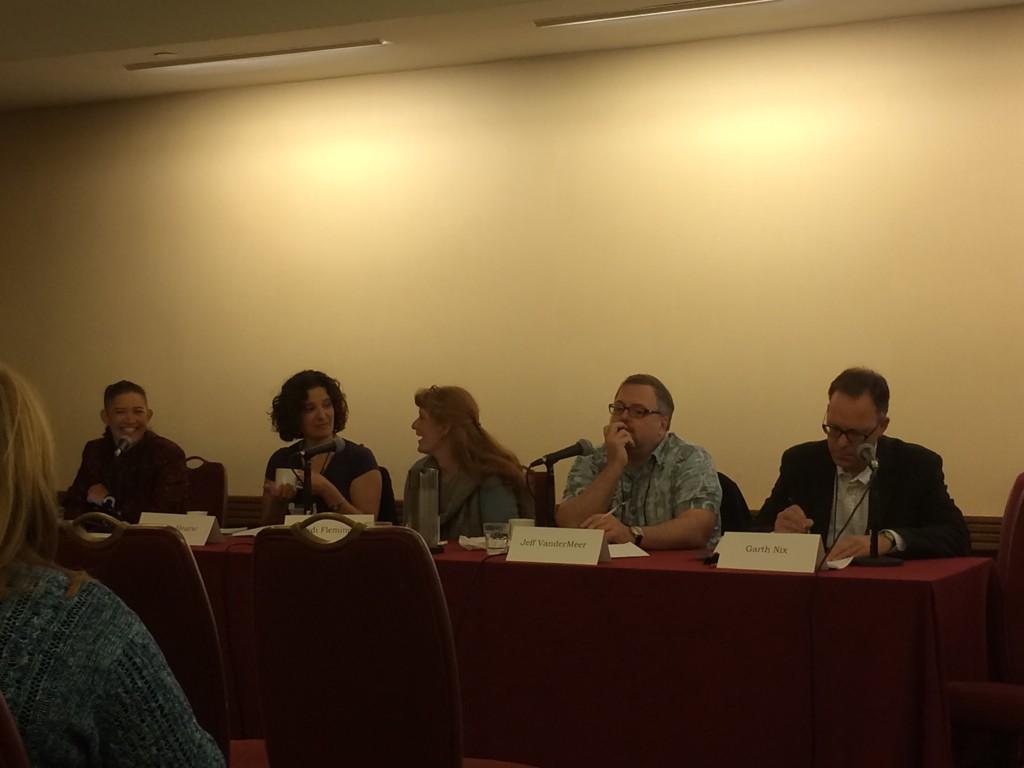
Aside: Some observances from my experience which may be of use to future panelists/moderators: It is incredibly helpful to talk to your fellow panelists beforehand. Even if it’s just an email correspondence, you want to get a feeling for what the other people are interested in, where their strengths are, who needs encouragement and who might need a little reining. If you can, make face-to-face contact before the panel. Ideally get everyone together in the same room and discuss how the show will be run, what topics are important to people, and what topics should be avoided. At the very least, if you see them beforehand, go up and introduce yourself—which I actually got to do with all four of my panelists, though I didn’t see Jeff until our paths converged en route to the location of the panel. Dorothy and I managed to get a meal together on Thursday night, which was nice since we’d never met before, and though I didn’t get a chance to visit with Garth or Judi beforehand, I had met Garth at previous cons, and Judi and I bonded over the course of the panel as fellow horse-people. We are also both artists (though of very different mediums) and so our paths kept crossing in that regard. In addition to her writing, Judi also makes wonderful decorated gourd art—from fanciful animals to elegant vases and ornaments—and is altogether a delightful character.
In many ways, however, this con was a little like revisiting old favorites. I got to see John Picacio, who is a bit like my artistic fairy godfather, as well as Lee Moyer (who improves any weekend), and my friend from Toronto, Angela Keeley (ditto). John’s assistant, Tara, was also there, and it was good to see her again. I don’t understand people who do not appreciate assistants. They work just as hard as their employers (in some areas, even more so) and are the people you actually want to talk to if you want anything from said employers. This was how Tara and I met, and now we’re friends as well.
Lee has an assistant too. Her name is Venetia Charles and, along with myself and Angela, we formed the unofficial Mohawk Ladies group. People were forever coming up to me and Angela, or me and Venetia, or (I assume) Venetia and Angela, and saying “Did you know there’s another woman with that haircut around here?”
My favorite, however, was when Ginjer Buchanan came at me and said, “You didn’t tell me you were in the art show!”
Which was confusing, since I had told her exactly that the night before at the ice cream social (where we had met).
“No,” she said, when I expressed this confusion. “I mean you,” she jabbed a finger at my chest, “are in the art show! There’s a picture of you by Ruth Sanderson!”
By which I realized she meant the “Stealing Time” scratchboard piece featuring yet another young woman with shaved sides and a long mane of hair.
I had to explain to Ginjer that that was not, in fact, me, and that there also were two other women running around with similar haircuts.
It was decided, eventually, that we needed to get a group picture of the three of us, with the picture. Which we finally managed to do at the Art Show Reception on Saturday night, with Ruth herself present to witness it. It was exactly as ridiculous and amazing and hilarious as you can imagine.
I still do not know who the model was for the picture, but I hope this story gets back to her eventually.
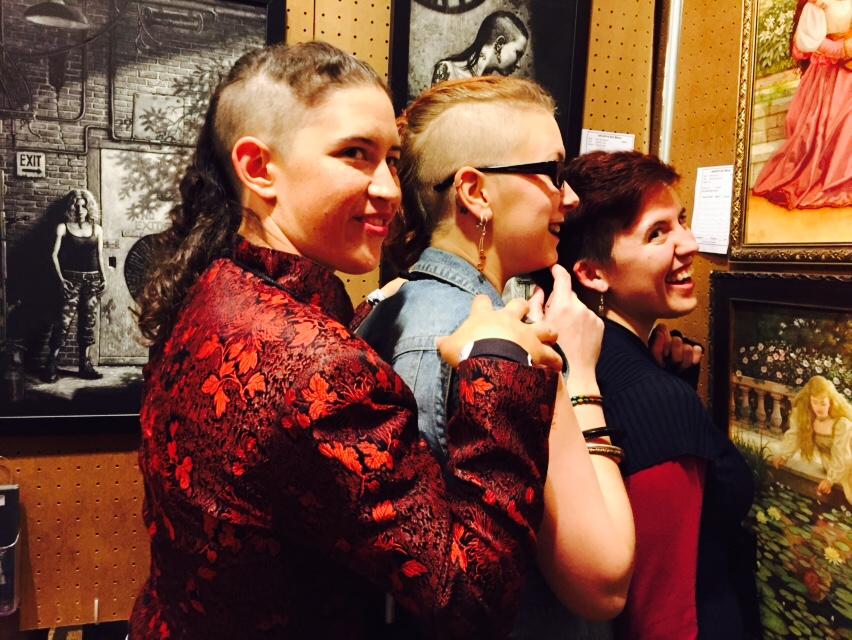
The Art Show this year was run by Michael and Elizabeth Zipster, and it was a powerhouse of a show. Big names like Sanderson, GoH Les Edwards, Greg Manchess, Charles Vess, Picacio, Michael Whalen; World Fantasy Award nominees Galen Dara and Kathleen Jennings, but also with relative unknowns such as Sharon Sasaki and Matthew Mrowka. Really, just go through the list of exhibiting artists and prepare to be blown away. It was both daunting and gratifying to be counted among them. But while the overall level of quality was uniformly high, the styles represented ranged from epic fantasy and science fiction, to dark, macabre horror, to whimsical and colorful, bright, shiny, understated, and fine mixes of any combination.
I know this, because I had to go through the entire show, panel by panel, piece by piece, while I filled out my ballot for the Virgil Finlay Centenary Award. This award, which was essentially a Best in Show with a thousand dollar cash prize attached, could only be voted on by attending artists, which was both a blessing and a curse. Too often I think art—particularly visual art—is judged by non-combatants, as it were, and I thought it was a handsome acknowledgement of the different perspectives of fellow artists that the vote was put exclusively to them. The winner turned out to be Greg Manchess, quite justifiably, for “Above the Timberline.” I only caught a part of his acceptance speech, in which he was understandably taken aback, and said something along the lines of “I don’t understand how I could have won, when there were so many other amazing works to vote for!”
Which I can sympathize with. In my voting I had eight pieces which I all liked equally, and picking three from them, and then picking the order of those three, was a long and agonizing process.
Later, on Sunday, I was talking to one of the World Fantasy nominees who wondered aloud what the judges were thinking when they picked the winners. I sympathized, and offered that, for what it was worth, I knew for a fact that the thoughts of one of the judges for the Virgil Centenary were: “What the actual *@^&! This is so *@^&ing hard I *@^&ing hate having to choose—what the %3!!!!”
Having had my fill of judged competition over ten years ago, when I swore off horse shows, you must forgive me if my feelings toward these sorts of awards are a little mixed. On the one hand, I think they are a lovely gesture showing appreciation for the contributions artists (both visual and literary) make to our culture. The cash prizes doesn’t hurt, either. However, I feel they sometimes bring a flavor of competition to a field whose strength lies in the fact that it is not a competition.
Which I firmly believe art is not. Artists may be pitted against each other for awards, writers might compete to see who can write the most words in a day, or for a spot in an anthology, but ultimately, as Molly Crabapple once said with far more eloquence than I am doing now (currently at Gate B9 in Chicago O’Hare): we artists are all we have, and we are the only ones who can save each other.
I would add that we are not participants in a competition or a sport: we are fellow warriors in a battle that is nebulous and vague, fought in shadows against invisible enemies such as depression, discouragement, bigotry, and our own inner demons. We need all the help we can get.
When I say artists here I mean, of course, everyone who creates art. And when I say art I mean art as Scott McCloud defines it: anything that is not one of the three essentials to our species: getting food, reproducing, or running away from danger. Which is a long way of saying I mean illustrators and writers. I’m making this distinction because a lot of people hear “artist” and think “painter” or something similar. But I don’t see the visual medium as being much different from the literary one. Perhaps because I learned to write and draw simultaneously, to me the two art forms are intimately connected; a symbiotic relationship between two animals, which are themselves different beasts than that wonderful melding of the two: comics. For me, much as science fiction, fantasy, horror, weird fiction—and what-have-you—stand under the same umbrella—so too does writing, drawing, painting, illustrating, and cartooning, and doing both—or all—comes naturally to me.
So I find it extremely interesting when I sit in on panels like “Artists who Take Up the Pen” and hear luminaries such as Ruth Sanderson and Charles Vess talk about how hard it is to be an artist/writer (or, it is implied, a writer/artist).
I know what they’re talking about, though. It is always difficult, when you have developed a highly advanced skill set in one area (as they have), to move to a different area in which you do not have such power.
It’s horrible. It’s worse than when you’re a kid and everything is difficult. Because you know how good you are at this one thing, and you know how far you have to go on this new thing. I think this towering precipice between mediums is what stops a lot of writers becoming illustrators, and vice versa.
Then there is the business element, which ruins so many things. From what I heard on that panel (and later from GoH Les Edwards at his kaffeeklatch), it seems traditional publishers are very stiff when it comes to making way for things they do not already have avenues for—and writer/illustrator creators are one of those things. The lingering stigma attached to comics doesn’t help.
So yes, there are definitely hardships when it comes to being artistically ambidextrous. But the advantages are staggering. If you can write and draw it more than doubles your creative capacity. A story can be words, or it can be illustrated—exactly as you want it—or it can be a comic, or it can be a painting! I liken it to those actors who were termed the Triple Threat: they could act, sing, and dance. Of course, that’s not such an advantage now as it was in the days of Kelly and Astaire, and perhaps that is the problem with the industry at this moment: it simply doesn’t know what to do with Double Threat creators. But I’d like to point out, just as the movie industry has moved away from musicals, our publishing industry might one day get to a point where having both these skills is an unmitigated advantage.
One can hope, and as a Double Threat myself, I certainly do. In the mean time, I can take advantage of the fact that I never have to worry about finding an artist to do covers for my books—or stories for me to illustrate.
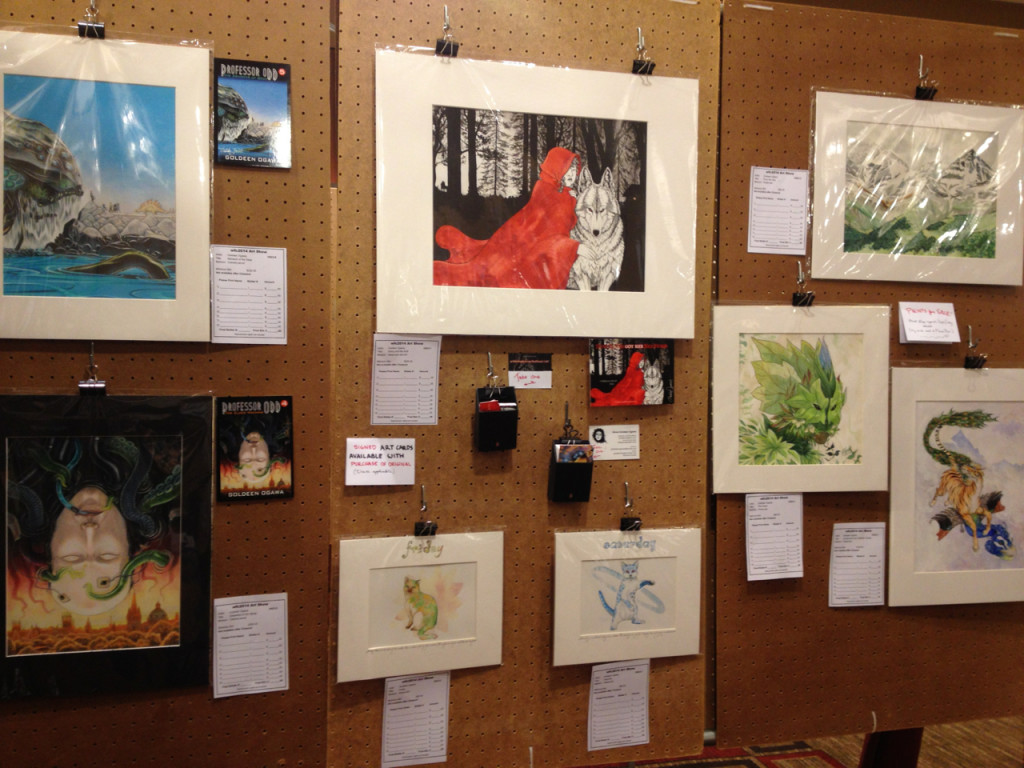
Getting back to the theme of old friends: I found a lot of familiar faces from my last World Fantasy (two years ago, in Toronto). Or rather, they found me. Apparently the impromptu badges I made people on Wednesday night in Toronto left an impression, which is both touching and flattering.
One face, however, didn’t need help. I was overjoyed to see Adria Laycraft, the co-editor of the Urban Greenman anthology, and it was only made more fun by the strong contingent of Greenman alumni present in Arlington. A few of us managed to meet for breakfast, and more showed up at Adria’s reading later that day.
Speaking of reunions, it was also good to see two of my Cut by a Girl friends: Nancy Greene and Keyan Bowes. Cut by a Girl is a little-known work, though I think more people will be interested since I had to retell the sword story that spawned the whole thing, and the topic kept cropping up. I fancy it has become the World Fantasy equivalent of the Noodle Incident, but unlike that mystery, you can find out what happened by simply reading the anthology.
All this, and I have not even scraped the surface of the many wonderful conversations and happy accidental meetings that made up the weekend. So many names, and I can barely remember half of them. Nina Niskanen and her fine Finnish friends. Patrick, the marine who shared a pizza with me. Greg, and his book about a hollow earth filled with imprisoned gods. Mari Ness, who has opened my eyes to what the world looks like when you have to roll everywhere (and kindly shared her dessert with me). Ellen Vartenhoff, the Marvel comics survivor. And so many more who’s names I cannot recall at the moment. It was lovely meeting all of you (and I really mean that: I don’t think I met a single creep at this entire convention). I want to thank Stuart David Schiff and his lovely wife Susan (and their son whose name I sadly did not get) for being kind and insightful luncheon companions at Sunday’s Award’s Banquet. Maybe you won’t believe me when I tell you that the editor of Whispers was entertained that day by an aspiring author telling him and his wife all about the process of making kefir, but that’s what happened. In return I got the hear the World Fantasy Awards presentation as annotated by Stuart David Schiff, and what was said then shall go unrecorded here, except to say that it made the whole process that much more entertaining.
I also want to shout out to all the wonderful readers who came and got me to sign their books: C.J. and both Seths, Kat, Cat, Amy, Apurva, and Alec, who was the first one to find me at the con (before Opening Ceremonies, no less) with his copy of Professor Odd #1, and was the last person to ask for an autograph, at the tail end of Monday’s breakfast, with Professor Odd #5. Because of the relative scarcity of 4 and 5, not everyone managed to complete their set, and I know for certain that only five people have complete signed sets. But anyone who’d like to complete their set can do so by going to the Professor Odd page at Heliopause Productions, selecting their chosen issues, and ordering them from their retailer of choice. Getting them signed might be a bit more difficult, but I’m working on a solution to that as well. Watch this space and my twitter (@GrimbyTweets) for an announcement regarding that.
A few people also asked how many Odds there were total, to which the answer is technically six, though the latest episode won’t appear until the Perihelion edition of Apsis Ficiton comes out this December, and it won’t be available as a single until January or February. Beyond that, however, I have twenty-four episodes planned, and am currently in the process of writing the twelfth one.
I want to thank the hotel’s staff, who were excellent; especially Woody at the concierge who pointed me in the direction of Bistro 7107 and told me to order the adobo (pro tip: go to Bistro 7107 and get the adobo). Also Sally and Larry, booksellers who gave me insight to what the business looks like from behind the dealer’s table, and who set me up with my copy of Creative Fire. Thanks to everyone who brought prints and cards and originals—you help make my dream a reality! I must mention John Picacio once again in order to thank him for being unfailingly kind, helpful, inspiring and generally awesome, as well as Charles Vess, who was generous enough to put a dragon in my Drakendillion.
Aside: I brought the doorstopper of a book to his table on Friday night, told him that his artbook/doorstopper had been a fixture on our coffee table for a month when it was meant to be changed out after one week, explained what the red and gold monstrosity in front of him was and that I would like him to sign the guest page, and had gotten as far as “…and one day I would be honored if you would put a dragon in it—not now, of course, I know you’re very busy—” when he snorted, grabbed the book, opened it to the first blank page, and started to draw.
Once I picked my jaw up off the floor I bummed a piece of scrap paper off the person in line behind me, and drew him a small, cramped thank-you card. It seemed the least I could do.
Finally, I’d like to thank Mary Robinette Kowal and Guy Gavriel Kay for hosting the Scotch tasting on Wednesday night. It was informative and tasty and introduced me to what will likely be a new favorite (Highland Park). It might seem strange to mention it here at the end, but it ties in to Sunday night, when I attempted to make a bottom-of-the-barrel blended whiskey edible by cutting it with water, coffee, and cream. Which turned it into something that was rubbish for whiskey, but rather good coffee. In future, however, I think I will stick to my Ls (Laphraoig and Lagavulin) if I’m going to be drinking alcohol. But it wasn’t a bad way to end what was an exceptionally good convention.
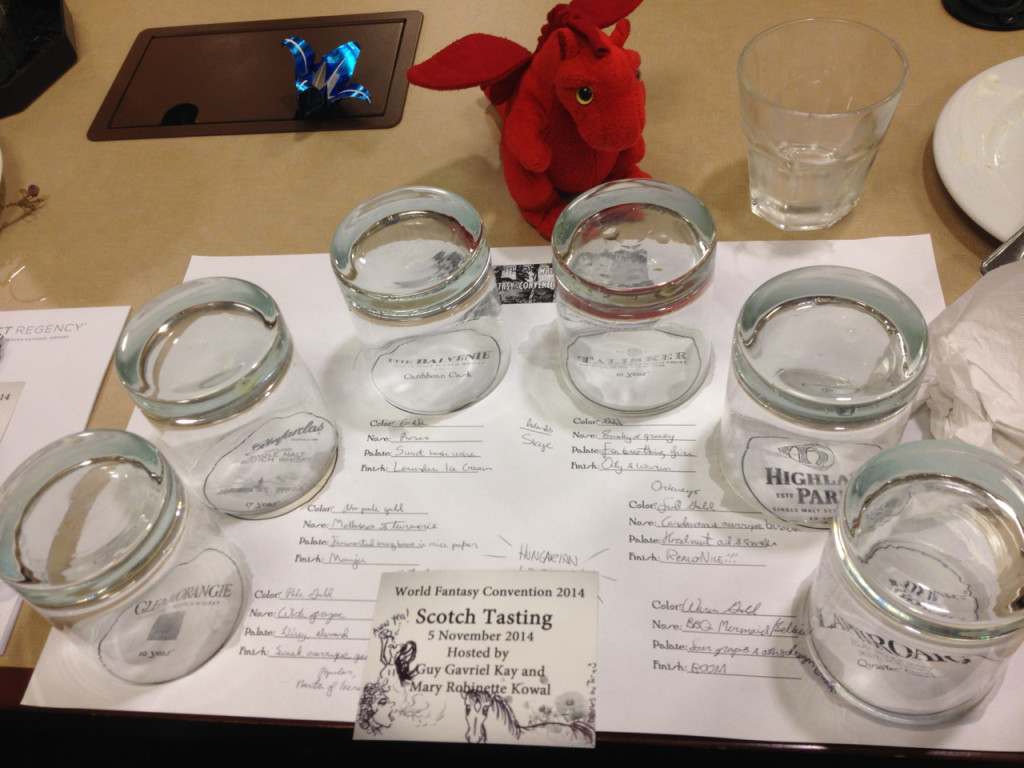
Looking to the future: I got asked a number of times about Saratoga next year, and it pains me to say it is highly unlikely that I will be going. I will, however, be in Spokane for WorldCon 2015, and I am adding Wiscon and DragonCon to the list of Cons I Really Must Go To Yes I Know It Makes My Year Really Crowded But They Look So FUN.
In the more immediate future: I swerve back into the Furry Fandom in January for Further Confusion in San Jose, where I will have art in the show and feet firmly planted in Tachyon’s paws, and after that it is the Long Push for AnthroCon in July. For more information about my 2015 convention appearances, check my About page, which should hopefully be updated soon.
I am on the plane to San Francisco now, and we have a few hours yet before we land, so I think I will end this now, and see if I can’t pick of the threads of the twelfth Professor Odd novella. Now I know people are really liking the series, I have more motivation than ever to write it.
~G
Goldeen Ogawa is a writer, illustrator and cartoonist. To keep tabs on what she is doing you can follow her on twitter @GrimbyTweets, and on Tumblr. You can also contact her directly.
